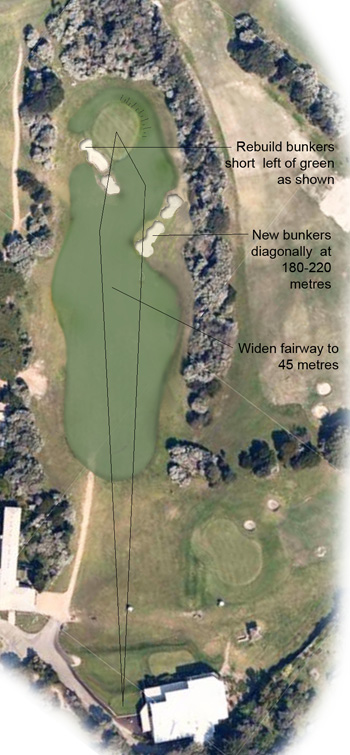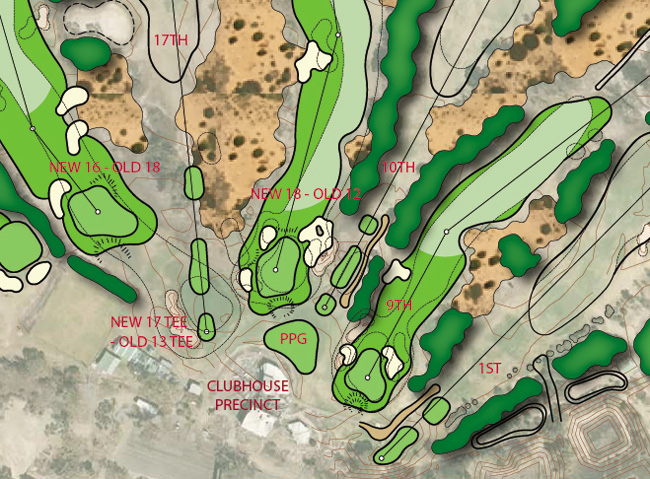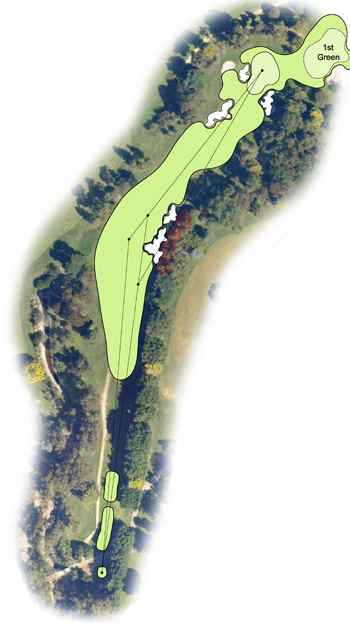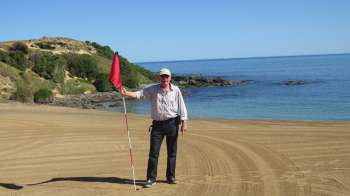In need of a Facelift - Part II
Following on from last month’s article about the hole that Australian golf architects would most like to redesign, we bring you the views and comments of an additional five course designers. Once more there is a mix of good holes that could be made better and poor holes in desperate need of repair.
Beyond the individual examples listed below, Michael Cocking from Ogilvy Clayton Golf Design made the observation that many clubs could simply change tee positions or the par of certain holes to build more interest into their courses. As Cocking notes, ‘using forward or alternate tees to create interest and variety is easy to achieve and there are lots of good examples – such as the 14th at Kingston Heath and the 8th at Metropolitan as par fours from the ladies tees. Also adding a back tee on the 16th at Royal Melbourne West and turning it into a short par four.’
Cocking acknowledges that adopting left-field concepts like this would require a significant shift in the mindset of golf club administrators and would be difficult under the new USGA rating regime. Regardless, it’s important to note that of the changes suggested by the various contributing architects here, only the 18th at Horsham would become longer or harder. Like last month’s selections, the rest of the holes can be improved simply by making them wider and more strategic to play.
Ben Davey – 1st Hole at Flinders Golf Club
 As a teenager I used to spend my school holidays roaming the Flinders Golf Course searching for golf balls, whacking them around with a 7 iron and getting myself into trouble for ‘nicking’ on to the golf course on the 10th tee without ever paying green fees. Local golfing identity Eric Lucas used to teach me how to putt on the 9th green in front of John Holland’s house. In the 80’s I played Junior Pennant for Flinders and so standing on the elevated tee of the 1st hole was always something I fondly remember. Filled with nerves and anticipation in the gaze of the clubhouse, the 1stwas always one of those holes, as a single marker, you were expected to par, but seemingly rarely did.
As a teenager I used to spend my school holidays roaming the Flinders Golf Course searching for golf balls, whacking them around with a 7 iron and getting myself into trouble for ‘nicking’ on to the golf course on the 10th tee without ever paying green fees. Local golfing identity Eric Lucas used to teach me how to putt on the 9th green in front of John Holland’s house. In the 80’s I played Junior Pennant for Flinders and so standing on the elevated tee of the 1st hole was always something I fondly remember. Filled with nerves and anticipation in the gaze of the clubhouse, the 1stwas always one of those holes, as a single marker, you were expected to par, but seemingly rarely did.
At just 244 metres, it was a hole where there was a clear decision to be made, whether to take the persimmon driver and bomb it at the green or lay-up short. The decision was usually determined by the wind, because given Flinders’ location on Bass Strait, the wind can certainly blow there! The prevailing southwesterly was right to left on the 1st, and the southerly was straight into it. Back in those days, before couch fairways, the ground in summer could be hard as rock, but the fairways were wide. The hole back then was simple but fun to play.
Fast forward 25 years and that same 1st hole (refer figure 1) is now a tight ‘bottleneck’ littered with randomly placed bunkers (7 in total!) where the best option is to hit a 7 iron from the tee leaving a wedge to the green. Unless a player can bomb a high 3 wood straight onto the green, there are no other sensible options because the fairway is now about 15 metres wide in the area most players hit it. This has been done (I assume) to ‘toughen up’ the hole.
The attached rendered aerial shows how simply and cost-effectively this hole could be made into a far more enjoyable short opener. It would require the following work:
- Trim back some of the ti-tree down the right side.
- Widen the cut fairway as shown.
- Re-bunker the hole as shown and reshape the greens surrounds
- Leave the green as it is
The resultant hole (figure 2) would provide far more options; whether to layup safely short and left leaving a tricky approach over the bunkers, play down the right for the better angled chip-shot into the green. Carry the diagonal bunkers on the right for a simpler chip shot on, or attempt to drive the green. Yes the fairway is wider and yes it is an easier task to hit the fairway, but which hole design asks more questions of a scratch player, which offers more options for the 15- 20 handicapper, and which would be more visually appealing and fun to play?
Michael Cocking – 2nd Hole at Kooyonga
Photos of Kooyonga from the 1920’s reveal an incredible golfing landscape, with an abundance of sand dunes and undulating ground – the two ingredients for truly great golf. Trees now cover these dunes and whilst many no doubt like the parkland feel, one could argue it has also been to its detriment. Could the land ever be returned to its former state…even just a little? It would be difficult, but what spectacular holes could be produced. Good holes such as the 8th could be great – perhaps one of the finest long holes in the country - with a little more short grass on top of the dune on the left rewarding the perfect drive, while anything left would find the sand and anything right is rejected by the slope on the fairway. Poorer holes, like the 9th, could be positively transformed, with sand in place of trees and golfers encouraged to play boldly across the large dunes at the promise of a birdie.
At the par five 2nd hole H.L. ‘Cargie’ Rymill discovered a wonderful green site, requiring second shots to be played through a narrow gap in the dunes. The wide, bunker-less fairway may have looked inviting but anything out of position required an awkward shot over (blind) or through the dunes to get close to the green. Most, no doubt, favoured the more cautious lay up short of the gap. Over the years changes have been made to presumably make the hole more difficult and retain its par. But I prefer the subtlety of Rymill’s original concept – which used the dunes as the primary hazard. And if this was deemed too easy, perhaps a switch of par should be considered? As like so many short fives around the country, a simple change to the number on the scorecard is the easiest and often the best solution to offset the technological advances of the last 2 decades - far better than making a series of changes to the golf course, which often distort, all for the sake of a number.
Paul Mogford – 12th Hole at Horsham Golf Club
Sadly the Horsham Golf Club was devastated by the infamous Black Saturday fires of February 2009, losing its clubhouse, maintenance shed and over 90% of its trees to the fire. With its new clubhouse currently under construction it is timely to discuss the improvements possible to the holes that play from and to the Clubhouse and in particular what will become, in our view, a cracking new finishing hole.
Presently there is an attractive array of greens and tees gracing the clubhouse precinct, including the 1st tee, 9th green, 10th tee, 12th green, 13th tee and 18th green. While it is not unheard of to have this many holes around the clubhouse, it is quite unusual given the space required. This has resulted in some structural issues that have been exacerbated by the tree loss from the fire. Golfer safety, in particular between the 10th and 13th tees - from balls approaching the 12th and 9th greens respectively - is now compromised. Another undesirable feature of the current routing is that the 18th finishes adjacent the less attractive neighbours of the practice fairway, practice green, bowling green and sheds.
This requires a reshuffle of the greens and tees mentioned above – however, the result would be startling and add much to the amenity of the Clubhouse precinct resulting in a strong and memorable set of concluding holes. In short, the current 18th green would move out of the immediate precinct and become the green for a new par five 16th. This would allow the 13th tees to safely move away from the 12th green greatly improving their safe relationship. The current 13th would then become the new 17th and the current 12th would play as the new 18th, which would finish, as is preferable, out in front of the clubhouse.
 Our changes will see the new finishing hole as a demanding par 4 of 392 metres. Presently the hole plays to a rise around 240m where a fairway bunker sits to the inside of the dogleg. As is too often the case this bunker sits as an island located well within the rough corridor, rather than effectively ‘interrupting’ the fairway cut and imposing upon the line of play. There are also a series of sandy hollows and hillocks which occur further to the right. Our proposal sees the fairway shifted to the right to better engage with these natural features. The new bunker is to bleed out of this sandy ground and provide a carry option for the long hitter and a hazard for most to negotiate. Add to this a new green pushed back and right complete with commensurate strategic bunkering and greater putting interest, the new 18th will result in a much improved and memorable finish forming the centrepiece of a more attractive and safe clubhouse precinct at Horsham Golf Club.
Our changes will see the new finishing hole as a demanding par 4 of 392 metres. Presently the hole plays to a rise around 240m where a fairway bunker sits to the inside of the dogleg. As is too often the case this bunker sits as an island located well within the rough corridor, rather than effectively ‘interrupting’ the fairway cut and imposing upon the line of play. There are also a series of sandy hollows and hillocks which occur further to the right. Our proposal sees the fairway shifted to the right to better engage with these natural features. The new bunker is to bleed out of this sandy ground and provide a carry option for the long hitter and a hazard for most to negotiate. Add to this a new green pushed back and right complete with commensurate strategic bunkering and greater putting interest, the new 18th will result in a much improved and memorable finish forming the centrepiece of a more attractive and safe clubhouse precinct at Horsham Golf Club.
Phil Ryan – 18th Hole at Keysborough Golf Club
Keysborough is a really good course with a good member atmosphere and I enjoy the layout but like every other member, in every golf club across Australia, when standing around on a tee waiting to hit, I often imagine how I could better this hole or that.
I have often stood on the tee at Hole 18 at Keysborough and thought about options, this is the last hole and the last hope of improving a score for the day. It is rated number 1 on the card and is even described on the Club web site as a monster. The hole is a long Par 4 for men (413m) and Par 5 for ladies (385m). On the right side the fairway edge is 38m from an adjoining road, obviously out of bounds. On the left the trees on the dogleg block any view of the green and about 165m out along the left is a sizable fairway bunker.
Due to the trees on the left of the dogleg, the men need to hit a shot of 260 to 270m to get a look at the green and you need to be middle to right on the fairway to be able to go over them. For ladies the trees on the dogleg give little options other than just hitting down the right side and if going for the green in three having to hit over the green side / front bunker every time.
A monster indeed, with not a lot of options. My thoughts standing on the tee are twofold. Firstly safety, the hole design pushes golfers to the right with the left forward fairway bunker and trees on the dogleg combining to block the left side. Most golfers aim to the right side of the fairway and this has golf dangerously close to the road.
Secondly options and reward. Set up the hole as per suggestion and have golfers play a line closer to the left, but by removing some (melaleucas) of the trees give the majority of golfers (ladies and men) the option of hitting for the green or better positioning of the ball for par.
The suggested small bunker and associated small rough (behind bunker) at 270m will still provide the longer hitters with a placement dilemma and the bunkers to the right side will guide golfers and assist to tighten up the longer landing zone.
Just for the record, I like trees but many golf clubs in Australia do not have a tree management program and often trees really intrude on a good golf hole. It sneaks up on Clubs as many trees were planted as small tubes by well meaning members but are either inappropriate species or just positioned incorrectly.

Todd Hyland – 8th Hole at Kew Golf Club
Kew has been my home club for almost 20 years and one day I hope the course will realise its full potential via careful, appropriate redesign work geared to injecting further strategic interest and options into the course. The 8th hole is an example where a substantial improvement to the strategic and aesthetic interest of the hole could be achieved without enormous capital expenditure. The hole is 375 metres long from the back men’s tee and plays out through a chute of trees doglegging to the right at about the 230 metre mark. The greenside bunkering is set back from the green on both the left and right sides.
 Currently some players gain the modest advantage of a shorter second shot by hugging the right hand side trees but approaches from the left are still quite straightforward. Because the dogleg is so far from the tee many male and female members hitting their tee shot to the right hand side are actually blocked by the trees on the inside corner of the dogleg.
Currently some players gain the modest advantage of a shorter second shot by hugging the right hand side trees but approaches from the left are still quite straightforward. Because the dogleg is so far from the tee many male and female members hitting their tee shot to the right hand side are actually blocked by the trees on the inside corner of the dogleg.
With modest tree removal on the corner of the dogleg everyone could receive benefit from playing to this side of the fairway and minimise the length of their second shot. This inside corner should be bunkered so that players have to flirt with these hazards to reap the reward. Longer hitters, and many members when playing from the white tees, would have the opportunity to try to take on the carry of the corner bunkers to gain further distance advantage. Like the 6th at Royal Melbourne West, although the green would be bunkered in tight to the left hand side and the green contoured so that the preferred approach angle is actually from as close to these bunkers as possible. Players who blast it over the top of the bunkers to the other side of the fairway are actually disadvantaged by a bad angle when compared to the clever accurate player who plays in close to the corner bunkers.
“The strategy of golf is the thing which gives the short accurate player a chance with a longer hitter who cannot control his (or her) direction or distance” - George Thomas Jnr
The green setting itself could be made significantly more beautiful and interesting with a bunker short of the green, the key greenside left bunker and another off to the right of the green to complete the setting.
What do you think?
Whether it’s changing a tee or completely ripping up a fairway, all golfers have stood on a green and been convinced that they know how to improve the hole they just played. We would be happy to hear readers thoughts on this subject, so feel free to send in your feedback on the poor holes at your club or perhaps answer the question, ‘if you were given your choice of any hole in Australia to redesign, which one would it be and how would you fix it?
Darius Oliver, Architecture Editor
Back to NewsMore News
Who Really Designed Cape Wickham Links?
AGD ranks Cape Wickham #1 in Australia & interviews Duncan Andrews to get full story on course design
Landmark professional golf tournament coming to Auckland
Pro golf will make a major return to NZ's largest city next March with event hosted by Royal Auckland & Grange
Grace Kim confirmed for 2026 women's Australian Open
Australian star will headline the Women’s Open when it returns to Kooyonga Golf Course in March
AGF releases 2024/25 Impact Report, highlighting life-changing opportunities for young Australians
The Australian Golf Foundation Report reveals a year of progress in making golf more accessible, inclusive, and life-changing for young people



